Impact Assessment of Climate Change on Climate Potential Productivity in Central Africa Based on High Spatial and Temporal Resolution Data
Abstract
1. Introduction
2. Materials and Methods
2.1. Study Area
2.2. Data Sources and Preprocessing
- (1)
- Missing Data HandlingCRU TS v.4.04 employs spatial interpolation to fill missing station data, as described in Harris et al. [39]. This paper further excluded grids with >20% missing values in the study period to minimize uncertainty.
- (2)
- Bias Correction
- (3)
- Reprojection and Spatial AggregationOriginal 0.5° grids were reprojected to an equal-area projection, Mollweide, before zonal statistics to minimize area distortion in Africa’s low latitudes. Monthly NetCDF files were batch-converted to GeoTIFF in MATLAB 2022b, then masked with African boundaries in ArcMap ModelBuilder. In the Model Builder of ArcMap, this study performed batch clipping, averaging, and summing of raster images to obtain the raster data of mean annual temperature and precipitation in the Central African region.
- (4)
- CPP CalculationZero-precipitation grids were set to 0.01 mm to avoid computational errors in the Thornthwaite model. Annual CPP was computed in MATLAB 2022b using reprojected, bias-corrected temperature and precipitation inputs.
- (5)
- Temporal and Spatial AnalysisTo analyze both spatial and temporal patterns of climate variables across Central Africa, this study first extracted mean annual temperature and precipitation from the reprojected rasters. These spatial trend analyses were complemented by a comprehensive time-series examination, according to which this study applied zonal statistics to derive key climatic indicators, including annual means, maxima, and minima, for each subregion over the 1901–2019 study period. This dual analytical approach enabled us to simultaneously capture the geographical distribution of climate parameters and their long-term temporal variations across Central Africa.
2.3. Methodology
2.3.1. Climate Tendency Rate
2.3.2. Thornthwaite Memorial Model
2.3.3. Mann–Kendall Trend Test
2.3.4. Mann–Kendall–Sneyers Trend Test
3. Results
3.1. Spatio-Temporal Climate Patterns
3.2. Spatio-Temporal Patterns of CPP in Central Africa
- Pre-1936: Declining CPP (UF < 0), particularly significant during 1908–1922;
- Period of 1936–2006: Increasing CPP (UF > 0), with significant rise during 1950–1982;
- Post-2006: Non-significant trends.
3.3. Impacts of Climate Change on Central Africa’s CPP
4. Discussion
5. Conclusions and Implications
5.1. Main Conclusions
5.2. Policy Implications
Author Contributions
Funding
Data Availability Statement
Conflicts of Interest
References
- Schmidhuber, J.; Tubiello, F.N. Global food security under climate change. Proc. Natl. Acad. Sci. USA 2007, 104, 19703–19708. [Google Scholar] [CrossRef] [PubMed]
- Godfray, H.C.J.; Beddington, J.R.; Crute, I.R.; Haddad, L.; Lawrence, D.; Muir, J.F.; Pretty, J.; Robinson, S.; Thomas, S.M.; Toulmin, C. Food security: The challenge of feeding 9 billion people. Science 2010, 327, 812–818. [Google Scholar] [CrossRef]
- Niang, A.; Becker, M.; Ewert, F.; Dieng, I.; Gaiser, T.; Tanaka, A.; Senthilkumar, K.; Rodenburg, J.; Johnson, J.-M.; Akakpo, C.; et al. Variability and determinants of yields in rice production systems of West Africa. Field Crops Res. 2017, 207, 1–12. [Google Scholar] [CrossRef]
- Calzadilla, A.; Zhu, T.; Rehdanz, K.; Tol, R.S.; Ringler, C. Climate change and agriculture: Impacts and adaptation options in South Africa. Water Resour. Econ. 2014, 5, 24–48. [Google Scholar] [CrossRef]
- Jagtap, V.; Bhargava, S. Variation in the Antioxidant Metabolism of Drought Tolerantand Drought Susceptible Varieties of Sorghum Bicolor (L.) Moench. exposed to high light, low water and high temperature stress. J. Plant Physiol. 1995, 145, 195–197. [Google Scholar] [CrossRef]
- Austin, K.G.; Baker, J.S.; Sohngen, B.L.; Wade, C.M.; Daigneault, A.; Ohrel, S.B.; Ragnauth, S.; Bean, A. The economic costs of planting, preserving, and managing the world’s forests to mitigate climate change. Nat. Commun. 2020, 11, 5946. [Google Scholar] [CrossRef]
- Pearson, C.J.; Bucknell, D.; Laughlin, G.P. Modelling crop productivity and variability for policy and impacts of climate change in eastern Canada. Environ. Model. Softw. 2008, 23, 1345–1355. [Google Scholar] [CrossRef]
- Li, Z.; Wang, S.; Li, J. Spatial variations and long-term trends of potential evaporation in Canada. Sci. Rep. 2020, 10, 22089. [Google Scholar] [CrossRef]
- Qin, Z.; Huang, Y.; Zhuang, Q. Soil organic carbon sequestration potential of cropland in China. Glob. Biogeochem. Cycles 2013, 27, 711–722. [Google Scholar] [CrossRef]
- Cao, J.; Zhang, Z.; Tao, F.; Zhang, L.; Luo, Y.; Han, J.; Li, Z. Identifying the contributions of multi-source data for winter wheat yield prediction in China. Remote Sens. 2020, 12, 750. [Google Scholar] [CrossRef]
- Kontgis, C.; Schneider, A.; Ozdogan, M.; Kucharik, C.; Tri, V.P.D.; Duc, N.H.; Schatz, J. Climate change impacts on rice productivity in the Mekong River Delta. Appl. Geogr. 2019, 102, 71–83. [Google Scholar] [CrossRef]
- Lachaud, M.A.; Bravo-Ureta, B.E.; Ludena, C.E. Economic effects of climate change on agricultural production and productivity in Latin America and the Caribbean (LAC). Agric. Econ. 2022, 53, 321–332. [Google Scholar] [CrossRef]
- Ibe, G.O.; Amikuzuno, J. Climate change in Sub-Saharan Africa: A menace to agricultural productivity and ecological protection. J. Appl. Sci. Environ. Manag. 2019, 23, 329–335. [Google Scholar] [CrossRef]
- Müller, C.; Cramer, W.; Hare, W.L.; Lotze-Campen, H. Climate change risks for African agriculture. Proc. Natl. Acad. Sci. USA 2011, 108, 4313–4315. [Google Scholar] [CrossRef]
- Wheeler, T.; Von Braun, J. Climate change impacts on global food security. Science 2013, 341, 508–513. [Google Scholar] [CrossRef]
- Müller, C. African lessons on climate change risks for agriculture. Annu. Rev. Nutr. 2013, 33, 395–411. [Google Scholar] [CrossRef] [PubMed]
- Knox, J.; Hess, T.; Daccache, A.; Wheeler, T. Climate change impacts on crop productivity in Africa and South Asia. Environ. Res. Lett. 2012, 7, 034032. [Google Scholar] [CrossRef]
- Descheemaeker, K.; Oosting, S.J.; Homann-Kee Tui, S.; Masikati, P.; Falconnier, G.N.; Giller, K.E. Climate change adaptation and mitigation in smallholder crop–livestock systems in sub-Saharan Africa: A call for integrated impact assessments. Reg. Environ. Change 2016, 16, 2331–2343. [Google Scholar] [CrossRef]
- Jagtap, S.S. Environmental characterization of the moist lowland savanna of Africa. In Moist Savannas of Africa: Potentials and Constraints for Crop Production: Proceedings of an IITA/FAO Workshop Held from 19–23 September 1994, Cotonou, Republic of Benin; Kang, B., Akobundu, I., Manyong, V., Carsky, R., Sanginga, N., Kueneman, E., Eds.; IITA: Cotonou, Benin, 1995; pp. 9–30. [Google Scholar]
- Nicholson, S.E. Climatic and environmental change in Africa during the last two centuries. Clim. Res. 2001, 17, 123–144. [Google Scholar] [CrossRef]
- Ogundari, K.; Onyeaghala, R. The effects of climate change on African agricultural productivity growth revisited. Environ. Sci. Pollut. Res. 2021, 28, 30035–30045. [Google Scholar] [CrossRef]
- Li, H.; Zhang, X. A spatial explicit assessment of food security in Africa based on simulated crop production and distribution. J. Clean. Prod. 2017, 147, 628–636. [Google Scholar] [CrossRef]
- Kohli, M.; Mijiddorj, T.N.; Suryawanshi, K.R.; Mishra, C.; Boldgiv, B.; Sankaran, M. Grazing and climate change have site-dependent interactive effects on vegetation in Asian montane rangelands. J. Appl. Ecol. 2021, 58, 539–549. [Google Scholar] [CrossRef]
- Yang, C.Y.; Wang, C.C.; Lu, C.C.; Chiu, Y.H.; Chiu, S.Y. Evaluating the impact of agricultural production efficiency on sustainable development goals in coffee-producing countries in Africa. Sustain. Dev. 2024, 32, 3375–3388. [Google Scholar] [CrossRef]
- Cui, Z.; Zhang, H.; Chen, X.; Zhang, C.; Ma, W.; Huang, C.; Zhang, W.; Mi, G.; Miao, Y.; Li, X.; et al. Pursuing sustainable productivity with millions of smallholder farmers. Nature 2018, 555, 363–366. [Google Scholar] [CrossRef]
- Zhang, W.; Cao, G.; Li, X.; Zhang, H.; Wang, C.; Liu, Q.; Chen, X.; Cui, Z.; Shen, J.; Jiang, R.; et al. Closing yield gaps in China by empowering smallholder farmers. Nature 2016, 537, 671–674. [Google Scholar] [CrossRef]
- Olanipekun, I.O.; Olasehinde-Williams, G.O.; Alao, R.O. Agriculture and environmental degradation in Africa: The role of income. Sci. Total Environ. 2019, 692, 60–67. [Google Scholar] [CrossRef] [PubMed]
- Jalloh, A.; Nelson, G.C.; Thomas, T.S.; Zougmoré, R.B.; Roy-Macauley, H. (Eds.) West African Agriculture and Climate Change: A Comprehensive Analysis; International Food Policy Research Institute: Washington, DC, USA, 2013. [Google Scholar]
- Lieth, H. Modeling the primary productivity of the world. Prim. Product. Biosph. 1975, 14, 237–263. [Google Scholar]
- Schulze, R.E.; Kiker, G.A.; Kunz, R.P. Global climate change and agricultural productivity in southern Africa. Glob. Environ. Change 1993, 3, 330–349. [Google Scholar] [CrossRef]
- Barrios, S.; Ouattara, B.; Strobl, E. The impact of climatic change on agricultural production: Is it different for Africa? Food Policy 2008, 33, 287–298. [Google Scholar] [CrossRef]
- Roudier, P.; Sultan, B.; Quirion, P.; Berg, A. The impact of future climate change on West African crop yields: What does the recent literature say? Glob. Environ. Change 2011, 21, 1073–1083. [Google Scholar] [CrossRef]
- Sultan, B. Global warming threatens agricultural productivity in Africa and South Asia. Environ. Res. Lett. 2012, 7, 041001. [Google Scholar] [CrossRef][Green Version]
- Abraham, B.; Araya, H.; Berhe, T.; Edwards, S.; Gujja, B.; Khadka, R.B.; Koma, Y.S.; Sen, D.; Sharif, A.; Styger, E.; et al. The system of crop intensification: Reports from the field on improving agricultural production, food security, and resilience to climate change for multiple crops. Agric. Food Secur. 2014, 3, 4. [Google Scholar] [CrossRef]
- Zhao, J.; Kong, X.; Jiang, Y.; Qian, Y. Impact Assessment of Climate Change on Climatic Potential Productivity in Global Major Agricultural Regions Based on High Spatial and Temporal Resolution Data. Ecol. Environ. Sci. 2019, 28, 1. [Google Scholar]
- Li, Z.; Duan, C.; Jin, L.; Hu, X.; Li, B.; Yang, H.Y. Spatial and temporal variability of climatic potential productivity in Yunnan Province, China. Chin. J. Appl. Ecol. 2019, 30, 2181–2190. [Google Scholar]
- Ren, Q.; Weng, L.; Gu, K.; Wu, X.; Xie, Q.; Luo, H. Spatiotemporal Variation Characteristics of Climate Potential Production in Guizhou Province. Chin. J. Agrometeorol. 2025, 46, 872–882. [Google Scholar]
- Bi, M.; Wan, L.; Zhang, Z.; Zhang, X.; Yu, C. Spatio-temporal variation characteristics of North Africa’s climate potential productivity. Land 2023, 12, 1710. [Google Scholar] [CrossRef]
- Harris, I.; Osborn, T.J.; Jones, P.; Lister, D. Version 4 of the CRU TS monthly high-resolution gridded multivariate climate dataset. Sci. Data 2020, 7, 109. [Google Scholar] [CrossRef]
- Sun, Q.; Miao, C.; Hanel, M.; Borthwick, A.G.; Duan, Q.; Ji, D.; Li, H. Global heat stress on health, wildfires, and agricultural crops under different levels of climate warming. Environ. Int. 2019, 128, 125–136. [Google Scholar] [CrossRef]
- Beck, H.E.; Wood, E.F.; Pan, M.; Fisher, C.K.; Miralles, D.G.; van Dijk, A.I.J.M.; McVicar, T.R.; Adler, R.F. MSWEP V2 global 3-hourly 0.1° precipitation: Methodology and quantitative assessment. Bull. Am. Meteorol. Soc. 2019, 100, 473–500. [Google Scholar] [CrossRef]
- Sneyers, R. On the Statistical Analysis of Series of Observations; Technical Note No. 143, WMO No. 415; World Meteorological Organization: Geneva, Switzerland, 1990. [Google Scholar]
- Oladipo, E.O. Drought in Northern Nigeria: An indication of abrupt climatic change? Weather. Clim. 1993, 13, 34–39. [Google Scholar] [CrossRef]
- Tabari, H.; Talaee, P.H. Analysis of trends in temperature data in arid and semi-arid regions of Iran. Glob. Planet. Change 2011, 79, 1–10. [Google Scholar] [CrossRef]
- Yue, S.; Pilon, P.; Phinney, B.; Cavadias, G. The influence of autocorrelation on the ability to detect trend in hydrological series. Hydrol. Process. 2002, 16, 1807–1829. [Google Scholar] [CrossRef]
- Jones, A.; Breuning-Madsen, H.; Brossard, M.; Dampha, A.; Deckers, J.; Dewitte, O.; Hallett, S.; Jones, R.; Kilasara, M.; Le Roux, P. Soil Atlas of Africa; European Commission, Publications Office of the European Union: Luxembourg, 2013. [Google Scholar]
- Fan, Y.; Miguez-Macho, G.; Jobbágy, E.; Otero-Casal, C. Hydrologic regulation of plant rooting depth. Proc. Natl. Acad. Sci. USA 2017, 114, 10572–10577. [Google Scholar] [CrossRef]
- Zhou, L.; Tian, Y.; Myneni, R.B.; Ciais, P.; Saatchi, S.; Liu, Y.Y.; Piao, S.; Chen, H.; Vermote, E.F.; Song, C.; et al. Widespread decline of Congo rainforest greenness in the past decade. Glob. Change Biol. 2014, 20, 2943–2954. [Google Scholar] [CrossRef]
- Malhi, Y.; Doughty, C.; Galbraith, D. The allocation of ecosystem net primary productivity in tropical forests. Philos. Trans. R. Soc. B Biol. Sci. 2015, 366, 3225–3245. [Google Scholar] [CrossRef] [PubMed]
- Quesada, C.A.; Lloyd, J.; Schwarz, M.; Patiño, S.; Baker, T.R.; Czimczik, C.; Fyllas, N.M.; Martinelli, L.; Nardoto, G.B.; Schmerler, J.; et al. Variations in chemical and physical properties of Amazon forest soils in relation to their genesis. Biogeosciences 2010, 7, 1515–1541. [Google Scholar] [CrossRef]
- Vitousek, P.M.; Porder, S.; Houlton, B.Z.; Chadwick, O.A. Terrestrial phosphorus limitation: Mechanisms, implications, and nitrogen-phosphorus interactions. Ecol. Appl. 2010, 20, 5–15. [Google Scholar] [CrossRef] [PubMed]
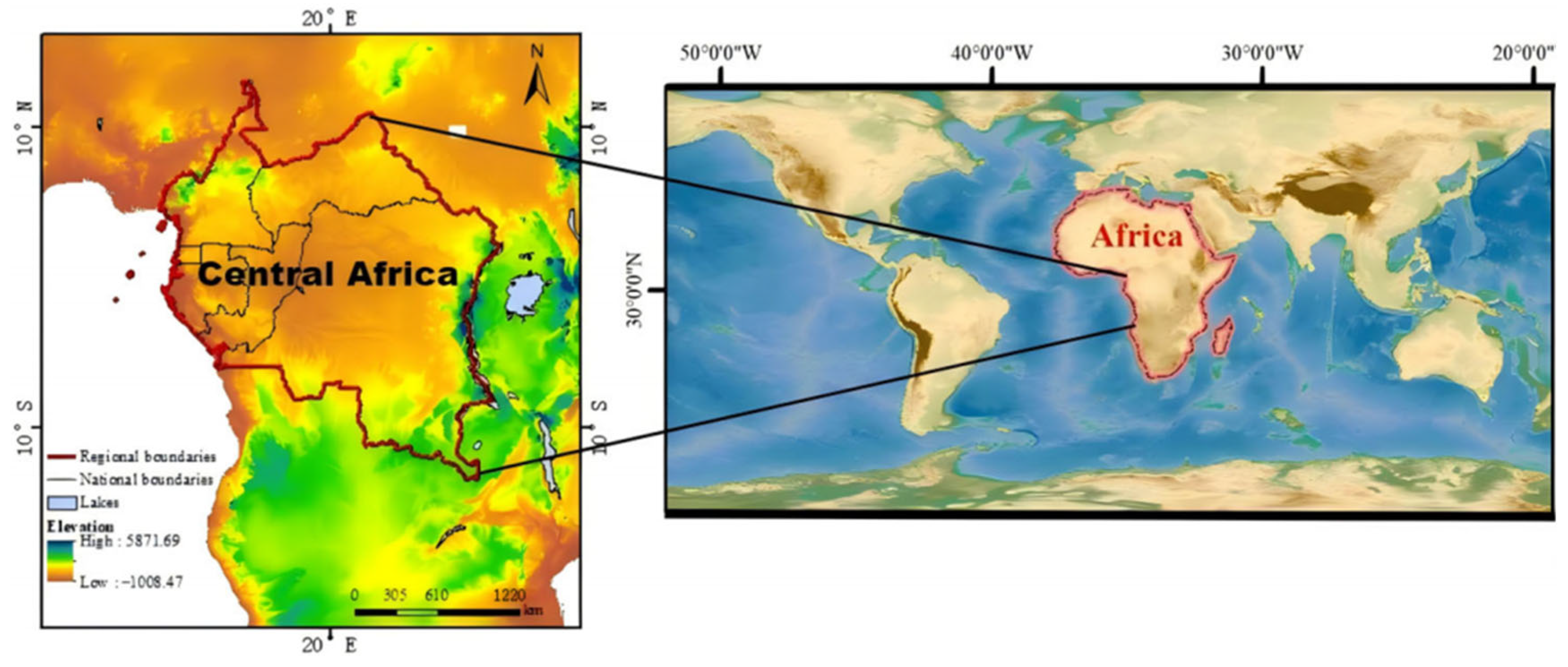
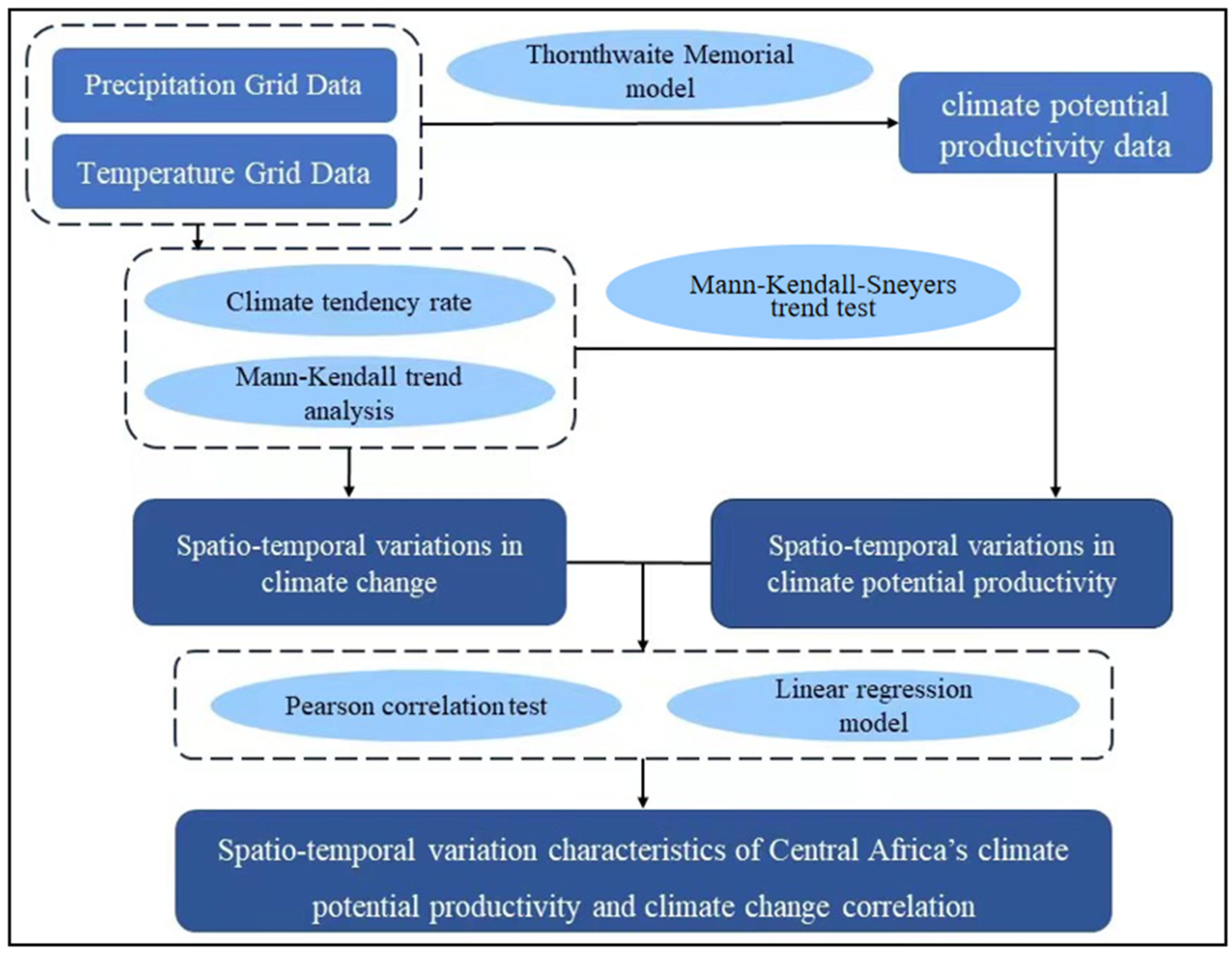
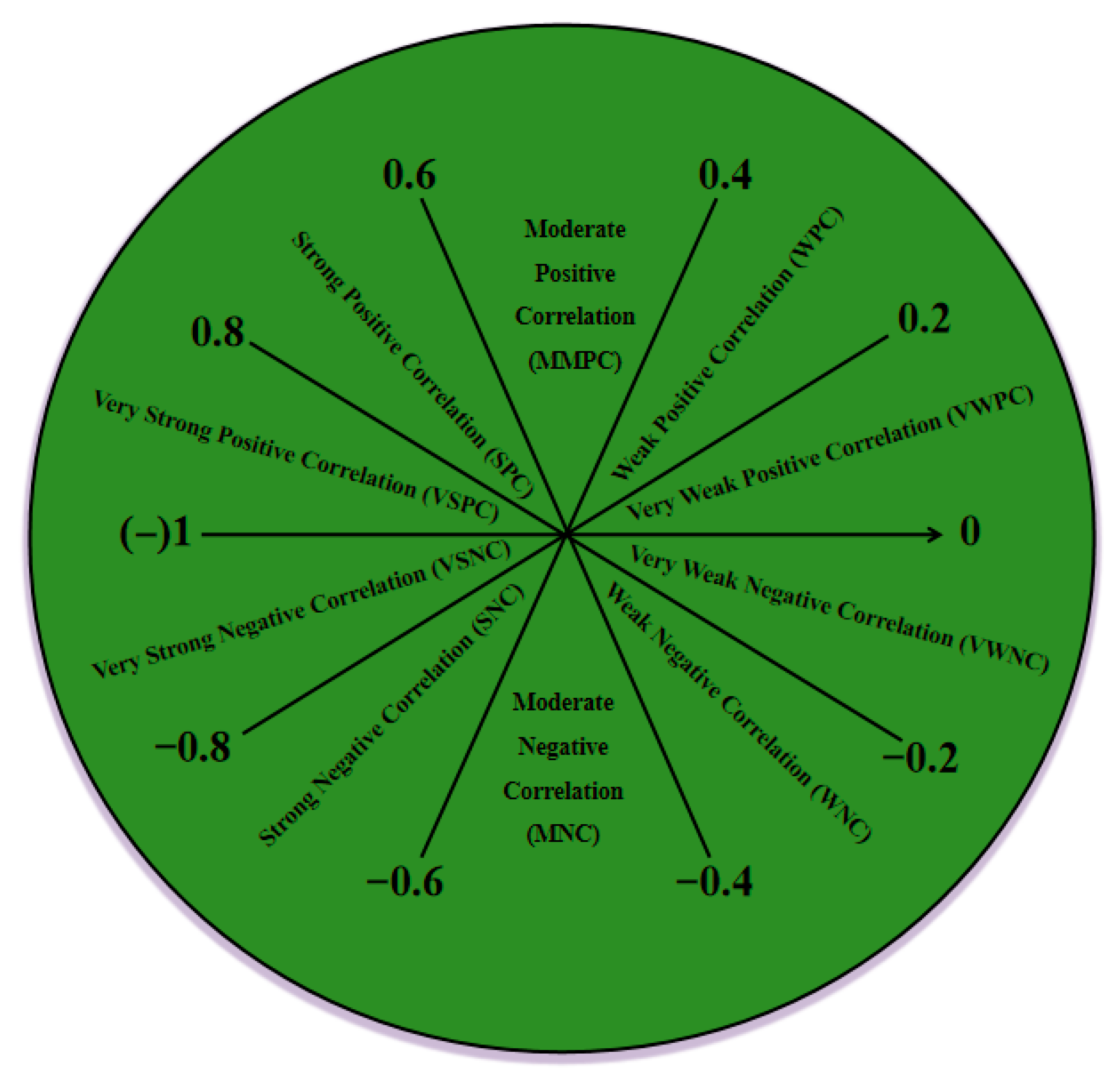
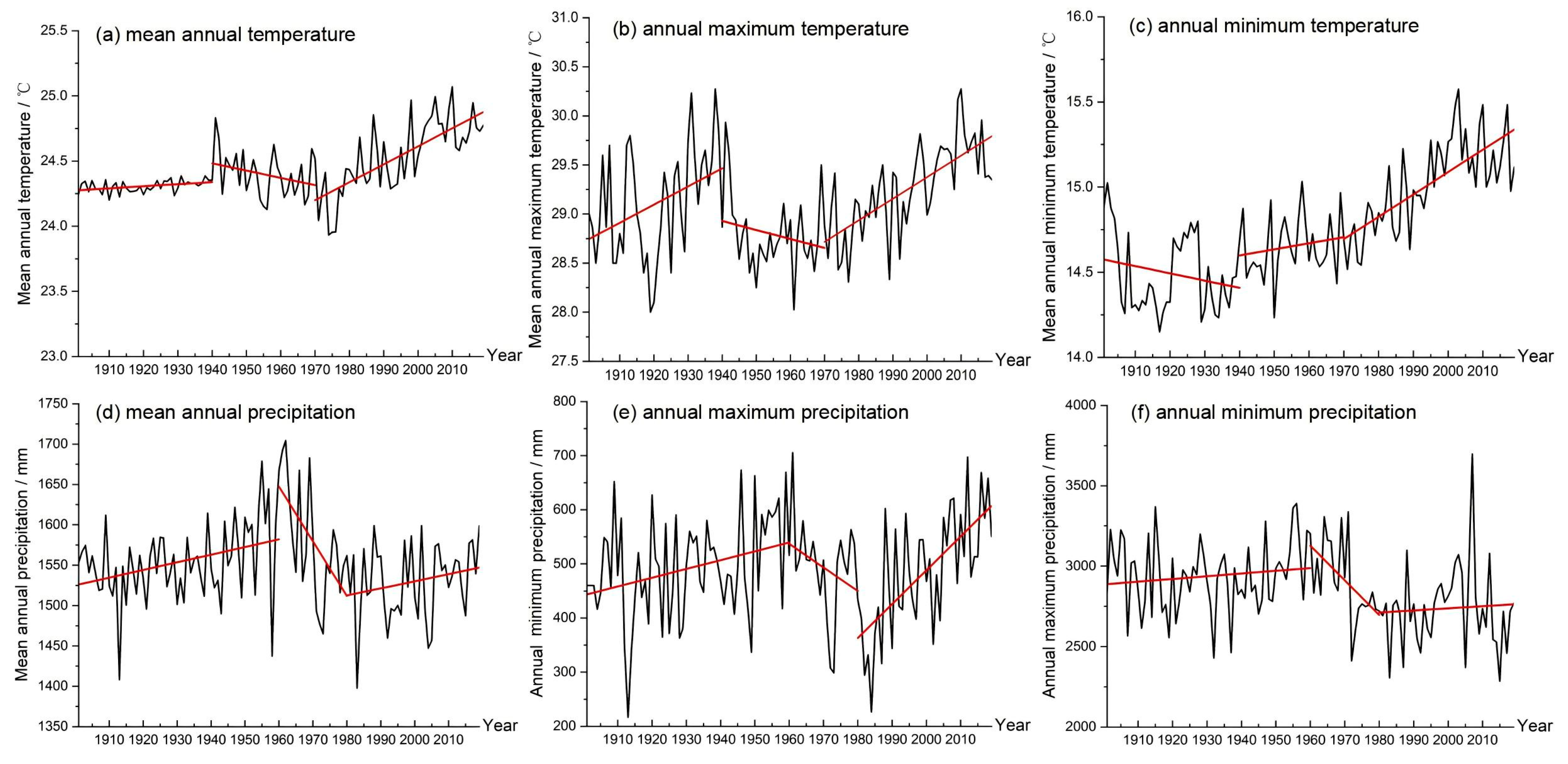
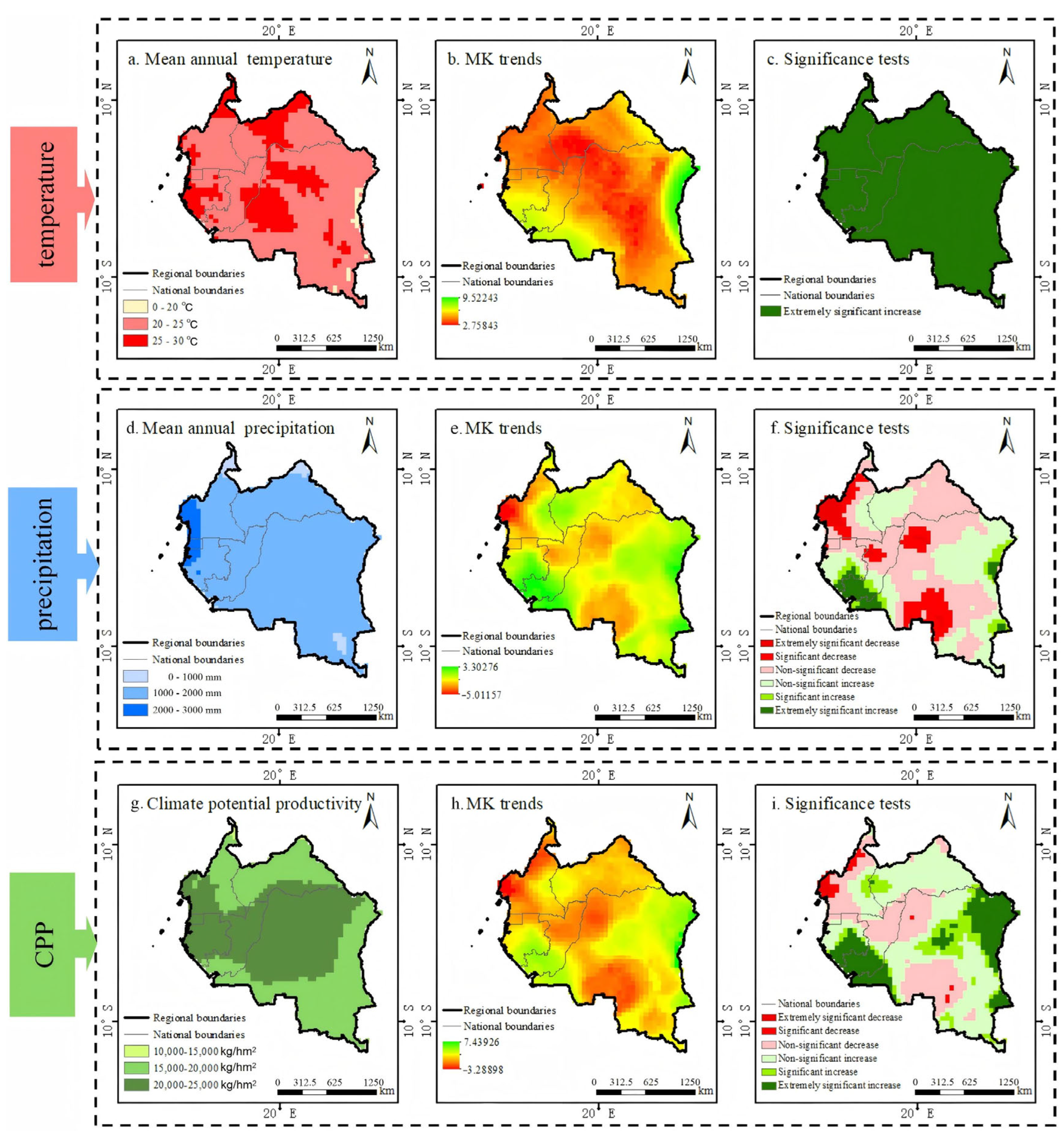
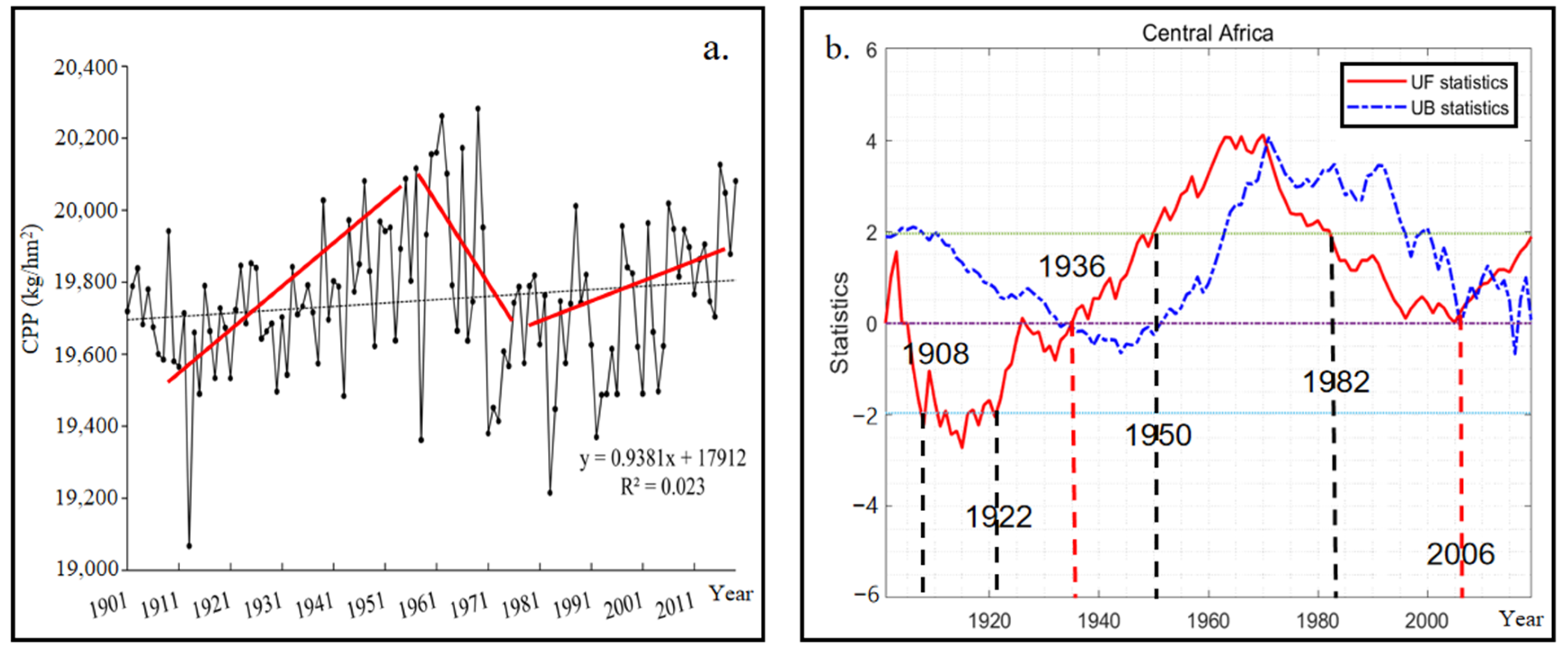

| Temperature (°C) | Proportion of Study Area (%) | Precipitation (mm) | Proportion of Study Area (%) | CPP (kg/hm2) | Proportion of Study Area (%) |
|---|---|---|---|---|---|
| 0−20 | 1.5 | 0−1000 | 2.7 | 10,000−15,000 | 0.6 |
| 20−25 | 73.0 | 1000−2000 | 93.4 | 15,000−20,000 | 48.0 |
| 25−30 | 25.5 | 1000−3000 | 3.9 | 20,000− | 51.4 |
| Significance | Temperature | Precipitation | CPP |
|---|---|---|---|
| Proportion of Study Area (%) | Proportion of Study Area (%) | Proportion of Study Area (%) | |
| Extremely significant decrease | 0 | 4.2 | 0.9 |
| Significant decrease | 0 | 9.8 | 1.7 |
| Non-significant decrease | 0 | 45.3 | 26.4 |
| Non-significant increase | 0 | 31.7 | 41.9 |
| Significant increase | 0 | 4.2 | 10.4 |
| Extremely significant increase | 100 | 4.8 | 18.7 |
| Correlation | Temperature | Precipitation |
|---|---|---|
| Proportion of Zoning Area (%) | Proportion of Zoning Area (%) | |
| WNC | 0.5 | 0 |
| VWNC | 16.7 | 0 |
| VWPC | 39.5 | 0 |
| WPC | 38.0 | 0 |
| MPC | 5.1 | 0 |
| SPC | 0.2 | 0.4 |
| VSPC | 0 | 99.6 |
Disclaimer/Publisher’s Note: The statements, opinions and data contained in all publications are solely those of the individual author(s) and contributor(s) and not of MDPI and/or the editor(s). MDPI and/or the editor(s) disclaim responsibility for any injury to people or property resulting from any ideas, methods, instructions or products referred to in the content. |
© 2025 by the authors. Licensee MDPI, Basel, Switzerland. This article is an open access article distributed under the terms and conditions of the Creative Commons Attribution (CC BY) license (https://creativecommons.org/licenses/by/4.0/).
Share and Cite
Bi, M.; Ren, F.; Xu, Y.; Guo, X.; Zhou, X.; van den Bersselaar, D.; Li, X.; Ren, H. Impact Assessment of Climate Change on Climate Potential Productivity in Central Africa Based on High Spatial and Temporal Resolution Data. Land 2025, 14, 1535. https://doi.org/10.3390/land14081535
Bi M, Ren F, Xu Y, Guo X, Zhou X, van den Bersselaar D, Li X, Ren H. Impact Assessment of Climate Change on Climate Potential Productivity in Central Africa Based on High Spatial and Temporal Resolution Data. Land. 2025; 14(8):1535. https://doi.org/10.3390/land14081535
Chicago/Turabian StyleBi, Mo, Fangyi Ren, Yian Xu, Xinya Guo, Xixi Zhou, Dmitri van den Bersselaar, Xinfeng Li, and Hang Ren. 2025. "Impact Assessment of Climate Change on Climate Potential Productivity in Central Africa Based on High Spatial and Temporal Resolution Data" Land 14, no. 8: 1535. https://doi.org/10.3390/land14081535
APA StyleBi, M., Ren, F., Xu, Y., Guo, X., Zhou, X., van den Bersselaar, D., Li, X., & Ren, H. (2025). Impact Assessment of Climate Change on Climate Potential Productivity in Central Africa Based on High Spatial and Temporal Resolution Data. Land, 14(8), 1535. https://doi.org/10.3390/land14081535







